News
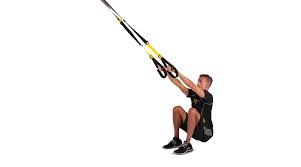
Design Your Own TRX Workouts
Learn how to develop your own TRX workouts by building TRX complexes. Want to find the perfect workout combinations for your fitness level? Take our quick assessment quiz to get personalized guidance on creating effective TRX circuits. These are sequences of TRX movements in a continuous circuit at very high intensity in a timed or reps/sets scheme with little or no rest between movements for a set number of rounds or time. A growing body of scientific literature including this recent study from the University of Denmark, Copenhagen supports the efficacy of high intensity training as compared to steady state aerobic training (what has traditionally been called "the fat burning zone"). The simplicity and versatility of the TRX allows users to create complexes perfectly tailored to their specific needs. Here are some guidelines for developing and implementing effective TRX complexes.
TAKE OUR TRAINING QUIZ
Step One: Balance of Basic Movements
If you're shooting for a complex geared towards whole body training and general conditioning, select a minimum of four exercises that cover all four basic human movements:
Pushing
Pulling
Squatting
Core
If you're new to TRX Suspension Training or working with a trainee who is new to TRX Suspension Training, this is a great starting point for designing a basic complex. A sample complex might look like this:
Pushing: TRX Chest Press
Pulling: TRX Low Row
Squatting: TRX Squat
Core: TRX Crunch
That's a solid first step for designing your own complexes. If you're more fit, working with more advanced trainees or seek a greater challenge, then Step Two is for you.
Step Two: Multi-planar Balance
The next step is to work from this basic premise to select exercises that also reflect a roughly even balance between the three fundamental planes of movement:
Frontal Plane
Sagittal Plane
Transverse Plane
*If you haven't read it yet, hustle over to Fraser Quelch's excellent article on planar training for a thorough look at the importance of this concept.
Step Three: More Multi-planar Bang for Your Buck
But keep in mind that many TRX movements task the body in more than one plane of movement. This means that the TRX allows you to select unique Suspension Training exercises for inclusion in the complexes you design that task the body in more than one plane of motion within a single movement.
For example, the TRX Power Pull turns the traditionally sagittal plane dominant motion of rowing into a movement that combines all three planes of movement—sagittal, transverse and frontal—by virtue of including rotational elements in addition to the linear, back-and-forth motion of a traditional two handed row (like the TRX Low Row).
Single leg and single arm TRX movements task the body in the transverse plane by virtue of requiring the body to generate anti-rotational force in the transverse plane in order to stay stable. Try a TRX Single Arm Row or TRX Single Arm Chest Press to experience this transverse plane anti-rotational challenge. When unilaterally performing the TRX Chest Press and TRX Low Row, part of the difficulty of these traditionally sagittal plane movements (pushing and pressing in a linear plane) becomes resisting the rotation that comes with the decreased stability of doing them with a single arm or leg.
You can find exercises in each of the four major categories of movement (push, pull, squat, core) to include in your complex that touch on all three planes of motion to achieve multi-planar balance.
Examples of squatting movements that task the body in all three planes of motion include the TRX Crossing Balance Lunge, TRX Lunge (with Rotation) and TRX Squat (Single Arm).Examples of core movements that task the body in all three planes of motion include the TRX Side Plank (with Tap), the TRX Oblique Crunch and the TRX Scorpion.
Here's a four exercise TRX complex utilizing exercises with internal multi-planar balance:
1. TRX Chest Press (Single Arm)2. TRX Power Pull3. TRX Crossing Balance Lunge (with Hop)4. TRX Oblique Crunch
Complexes can certainly include more than four exercises. But four is a solid starting point for basic complex design. You can also take a cue from the work of Coach Dos, Alwyn Cosgrove and the protocols found in the TRX Boot Camp: Ropes and Straps DVD and integrate other modalities or metabolic conditioning between TRX movements for an even more intense challenge.
A multi-modal complex might look like this:
TRX Chest Press
Bear Crawl
TRX Mountain Climber
Crab Crawl
TRX Lunge (with Rotation)
Overhead Med Ball Swing to Slam
TRX Burpees
Step Four: Execution
Now that you've selected your exercises, decide what scheme you will use to execute your complex—timed rounds, sets and reps or ascending or descending ladders (10-1, 1-10, etc.). However you set up your complex, be mindful that even when shooting for a maximum number of rounds, reps or sets within a given time frame, never sacrifice form. The key to effective training is to always use good form to reinforce correct movement patterns.
Now have at it!
Don't have a TRX Suspension Trainer yet? Get one here and get to work.
Andrew Vontz is a journalist and trainer who writes for TRX. He programs functional training for endurance sports and life.
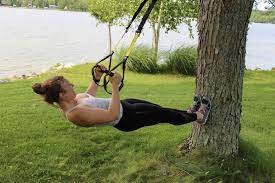
Deeper Dive into Diet
Body Transformation Series, Part 2 of 7
If you feel overwhelmed by all the conflicting nutrition and diet advice out there, you’re not alone. It seems that for every expert telling you a certain food is good, you’ll find others saying exactly the opposite. Healthy eating is not about strict dietary limitations, staying unrealistically thin, or depriving yourself of the foods you love. It’s about having more energy, improving your outlook, feeling great and stabilizing your mood.
We tend to think of “healthy eating” as some sort of deprivation or consequence of choosing to be fit over having a good time. But the truth is, developing an understanding of simple nutrition is actually quite easy. It’s the implementation part that is hard. As we work longer hours, we have less time to select and prepare food, leading to an increased reliance on fast food, ordering in and eating out – a loss of control over the of quantity and quality of the food we eat, including its preparation. Consequently, we eat more calories, sugar, salt, saturated and hydrogenated fat, running the risk of being shortchanged in other areas of nutrition. The convergence of these realities makes sound nutrition more important than ever. Understanding the pleasures and benefits of a healthy diet offers much satisfaction and even greater rewards, particularly if you are working towards a total body transformation.
Caloric intake
Caloric intake is simply the number of calories an individual consumes on a daily basis. To lose weight, you have to reduce the number of calories you consume below your Resting Metabolic Rate (RMR). The average RMR of an individual engaged in normal, daily activity (walking around the office, chores around the house, getting the mail, etc.) ranges from 1800-3000 kcal a day. Much depends, of course, on the amount of physical activity you get, gender, age, body size, height, lifestyle and overall general health, and it's different for everyone. According to the U.S Department of Health, the average adult male requires about 2,700 calories a day to maintain his weight, while the average female needs only 2,200 calories. Just to stay alive, we obviously need far less, but our bodies will function poorly if we consume too few. Contrary to popular belief, it is possible to consume too few calories, especially if you expect results from training. Your body must be properly nourished. To lose 1 pound, or 0.5kg per week, you will need to shave 500 calories from your daily menu. Try to lower your caloric intake gradually, and not less than 1,000 calories per day below RMR. Use the chart below to find your RMR.
Estimated RMR
RMR = 10 * weight (kg) + 6.25 * height (cm) - 5 * age(y) + 5 (man)
RMR = 10 * weight (kg) + 6.25 * height (cm) - 5 * age(y) - 161 (woman)
Think of your diet in terms of color, variety, and freshness. Focus on avoiding packaged and processed foods and opting for more fresh ingredients.
Food Choice
If you feel overwhelmed by all the conflicting nutrition and diet advice out there, you’re not alone. It seems that for every expert telling you a certain food is good, you’ll find others saying exactly the opposite. Healthy eating is not about strict dietary limitations, staying unrealistically thin, or depriving yourself of the foods you love. It’s about having more energy, improving your outlook, feeling great and stabilizing your mood. You can cut through the confusion and learn how to create a tasty, varied and healthy diet that is as good for your mind as it is for your body using these easy tips to transform daily eating habits. Ask yourself these 3 humble questions and the answers will guide you into your next snack or meal.
1) Am I even hungry?
It is the first question you should ask yourself before putting anything into your mouth. If you aren’t hungry but are feeling like its time to eat, you may be thirsty. Water helps flush our systems of waste products and toxins, yet many people go through life dehydrated—causing tiredness, low energy, and headaches. It’s common to mistake thirst for hunger, so staying well hydrated will also help you make healthier food choices.
2) Is it the best option?
Given an option between chips and a diet soda or fresh fruit, string cheese and water, what would be the best choice? When cutting back on unhealthy foods in your diet, it’s important to replace them with healthy alternatives. Replacing trans-fats with healthy fats (switching fried chicken for grilled fish) will make a positive difference. Instead of being overly concerned with counting calories, think of your diet in terms of color, variety, and freshness. Focus on avoiding packaged and processed foods and opting for more fresh ingredients.
3) How much will I need to satisfy my hunger?
When dining out, choose a starter instead of an entree, or split a dish with a friend. Visual cues can help with portion sizes–a serving of meat, fish, or chicken should be the size of a deck of cards. Enjoy ½ a cup of potato, rice, or pasta - it’s about the size of a light bulb. If you don't feel satisfied at the end of a meal, add more leafy green vegetables or fresh fruit.
Protein
Resistance training and protein intake are powerful stimulators for increased lean mass. If you want to turn ingested protein into muscle, a net positive protein balance (more synthesis than breakdown) is required. Without adequate protein in the diet, muscles cannot hypertrophy. Ingesting protein within a few hours of training, and over the subsequent 24-hour period increases the rate of protein synthesis. The best forms of protein are easily and rapidly digested and rich in essential amino acids, especially leucine. Whey protein found in milk is one source that meets both these goals. Although the current recommended amount of protein for sedentary individuals is 0.8 g per kg of body weight, those who train may need as much as 1.6-1.7g per kg of body weight. Eat plenty of fish, chicken, or plant-based protein such as beans, nuts, and soy. Replace processed carbohydrates from pastries, cakes, pizza, cookies and chips with fish, beans, nuts, seeds, peas, tofu, chicken, dairy, and soy products. Snack on nuts and seeds instead of chips, and replace baked desserts with Greek yogurt.
When to Eat
More and more research is determining that when you eat can be just as important to performance as what you eat. In fact, some studies suggest that if two athletes are performing the same training and eat exactly the same diet, the one who times her eating correctly will make the most performance gains. Nutrient timing requires the ability to time meals and snacks across a 24-hour period. Now we don’t all have the luxury of timing our meals and snacks with that much precision, but here are a few easy to follow guidelines that can help make your next workout great by fueling up with the right foods.
Pre-workout
Eating before a workout can give you the energy to power through a tough exercise session. Snacks before a workout should be carbohydrates combined with a moderate amount of protein. Try pairing a banana with a ½ cup of Greek yogurt; 8 oz. juice and a handful of pretzels, or a bagel or slice of toast with peanut butter. Consuming these types of snacks about two hours before exercise can help give you the appropriate energy for an awesome workout.
Post-Workout
After a tough workout, you have a 30-90 minute window of opportunity to replenish lost fuel sources. Good, post-workout choices include whole-wheat breads and pastas; fruit; vegetables and brown rice. These are low in fat and calories and can help with your weight-loss efforts. Lean protein sources also are important. Choices include skinless chicken, fish, low-fat dairy products, soy and nuts. Chocolate milk is an excellent choice. It has double the carbohydrate and protein content of white milk, contains leucine and is perfect for replenishing fatigued muscles. Plus it packs a nutritional bonus of calcium, and includes just a little sodium and sugar — additives that help recovering athletes retain water and regain energy.
Irene Lewis-McCormick M.S is Adjunct Faculty at Drake University, an SCW Fitness Education (SCW) Certification Master Trainer and the Education Director at Octane Fitness. An Orange Theory Fitness coach, she’s a twice published author (Human Kinetics) holding advisory board positions with Diabetic Living and the National Egg Council. Named Top 3 Group Fitness Instructor 2015 by IDEA Health & Fitness, Irene is a RYKA Ambassador and Subject Matter Expert for ACE. Irene presents education for SCW, ACSM, IDEA and NSCA. She is an SCW, TRX, Tabata Bootcamp, Barre Above, JumpSport and Octane Fitness master trainer. Certifications include SCW, ACSM, NSCA, ACE, AFAA & AEA.
Body Transformation Series, Part 1 of 7
Body Transformation Series, Part 2 of 7
Body Transformation Series, Part 3 of 7
Body Transformation Series, Part 4 of 7
Body Transformation Series, Part 5 of 7
Body Transformation Series, Part 6 of 7
Body Transformation Series, Part 7 of 7
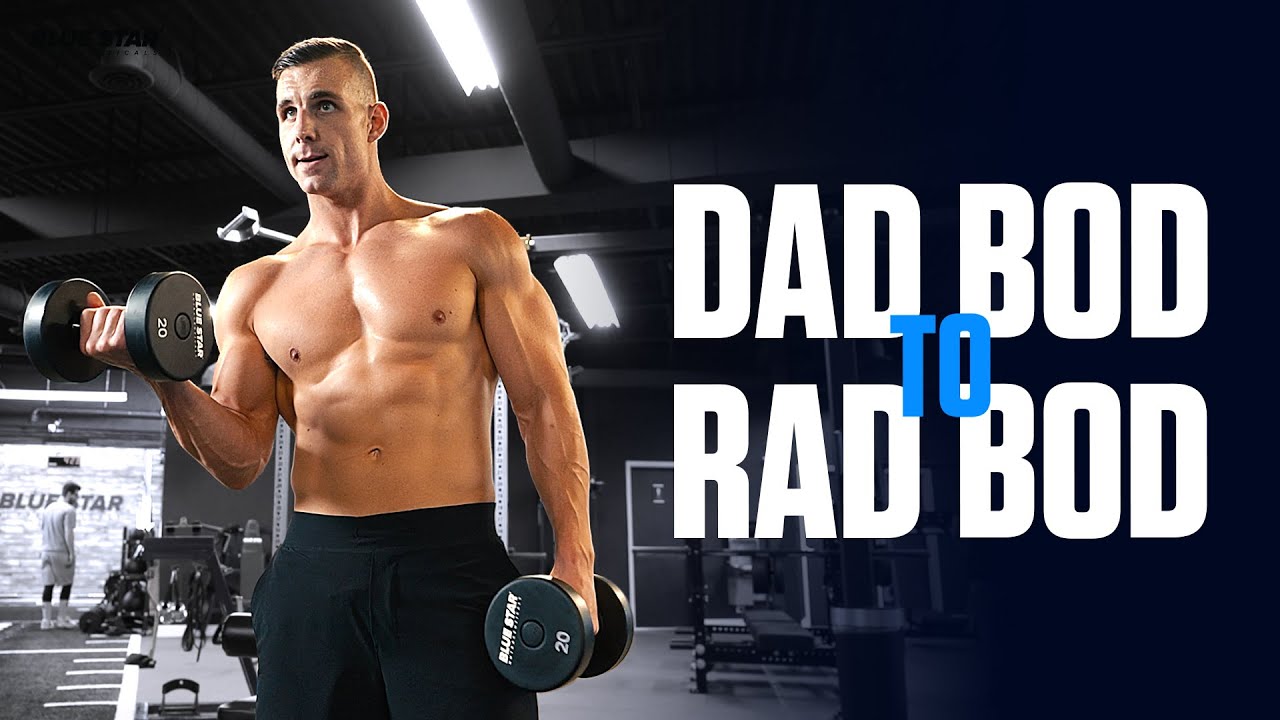
Dad Bod to Rad Bod Workout
Without a doubt, the Dad Bod has garnered more attention this year than ever before. If you’re looking to shed some excess dad weight, we’ve got a killer workout to trim down that baggage and transform you into a man of steel. Short and super effective, this workout develops upper-body strength and definition by targeting the back, arms, chest and waist, perfect for shedding that excess dad flab.
Move from exercise to exercise. When you finish the whole circuit, rest for 3-5 minutes and repeat two to five times through. Designed to be performed with a TRX Suspension Trainer, we have also provided a non-TRX version for each exercise.
TRX Chest Press (45 Seconds)Adjust the TRX to the fully lengthened position. Stand facing away from the anchor point with your feet shoulder width apart.Extend your arms in front of your shoulders, engage your core and begin to slowly lower your body by bending your elbows to 90 degrees.Drive through your palms and fully extend your arms to return to the start position. If the TRX straps rub against your arms during the movement, raise your hands slightly to correct.
Rest 15 Seconds
TRX Low Row (45 Seconds) Adjust the TRX to the fully shortened position. Stand facing the anchor point, with your feet together. Your palms should be facing each other, with your arms fully extended.Walk your feet toward the anchor point until you find a comfortable yet challenging angle. Bend your elbows, bringing your hands to the sides of your chest while squeezing your shoulder blades together.Keep your body planked throughout the movement, and do not allow your hips to sag.
Rest 15 Seconds
TRX Suspended Lunge (45 Seconds Left Leg)With the Suspension Trainer at mid calf length, face away from the anchor point with one foot in both foot cradles. Lunge down by driving your suspended knee back. Lower hips until your knee is two inches from ground and your front knee at 90 degrees. To return, drive through the heel of your grounded leg, squeeze glutes, lift chest and keep your eyes forward.
Rest 15 Seconds
TRX Suspended Lunge (45 Seconds Right Leg)With the Suspension Trainer at mid calf length, face away from the anchor point with one foot in both foot cradles. Lunge down by driving your suspended knee back. Lower hips until your knee is two inches from ground and your front knee at 90 degrees. To return, drive through the heel of your grounded leg, squeeze glutes, lift chest and keep your eyes forward.
Rest 15 Seconds
TRX Biceps Curl (45 Seconds)Adjust your Suspension Trainer to mid length and stand facing the anchor point with your elbows bent, just higher than shoulders. Align your pinkies with your temples and walk your feet toward the anchor point until there is a little tension in the biceps. Lower yourself down until your arms are fully extended while maintaining plank. Pull your body toward the anchor point by bringing pinkies back to your temples, elbows high, eyes on the anchor point.
Rest 15 Seconds
TRX Squat (45 Seconds)With your Suspension Trainer at mid length, stand facing the anchor point with your feet hip width apart. Stack your elbows under your shoulders and lower your hips down and back, keeping your weight in your heels. Squeeze your glutes and drive through your heels to return to the start position. Keep your chest lifted throughout the movement.
Rest 15 Seconds
TRX Mountain Climbers (45 Seconds)Adjust the Suspension Trainer to mid calf and start on the ground with your toes in the foot cradles in a plank position. Draw one knee in towards you chest while raising your hips and keeping your other leg straight. Lower your hips down and straighten out your leg to return to the start position. Repeat with the other leg.
Rest 15 Seconds
TRX Burpees (45 Seconds)With the Suspension Trainer at mid calf place one foot in both foot cradles.Drive your suspended leg back, lower your hips until back knee is two inches from ground. Place your hands on the ground and hop your grounded leg straight back to a plank position. Perform a pushup then hop your grounded leg forward and explode up to a jump.
_____________________________________
If you don’t have a TRX Suspension Trainer, try this bodyweight-only version:
Push Ups (45 Seconds)
Rest 15 Seconds
Overhand Bodyweight Rows (45 Seconds)
Rest 15 Seconds
Alternating Lunges (45 Seconds)
Rest 15 Seconds
Underhand Bodyweight Rows (45 Seconds)
Rest 15 Seconds
Bodyweight Squats (45 Seconds)
Rest 15 Seconds
Mountain Climbers (45 Seconds)
Rest 15 Seconds
Burpees (45 Seconds)
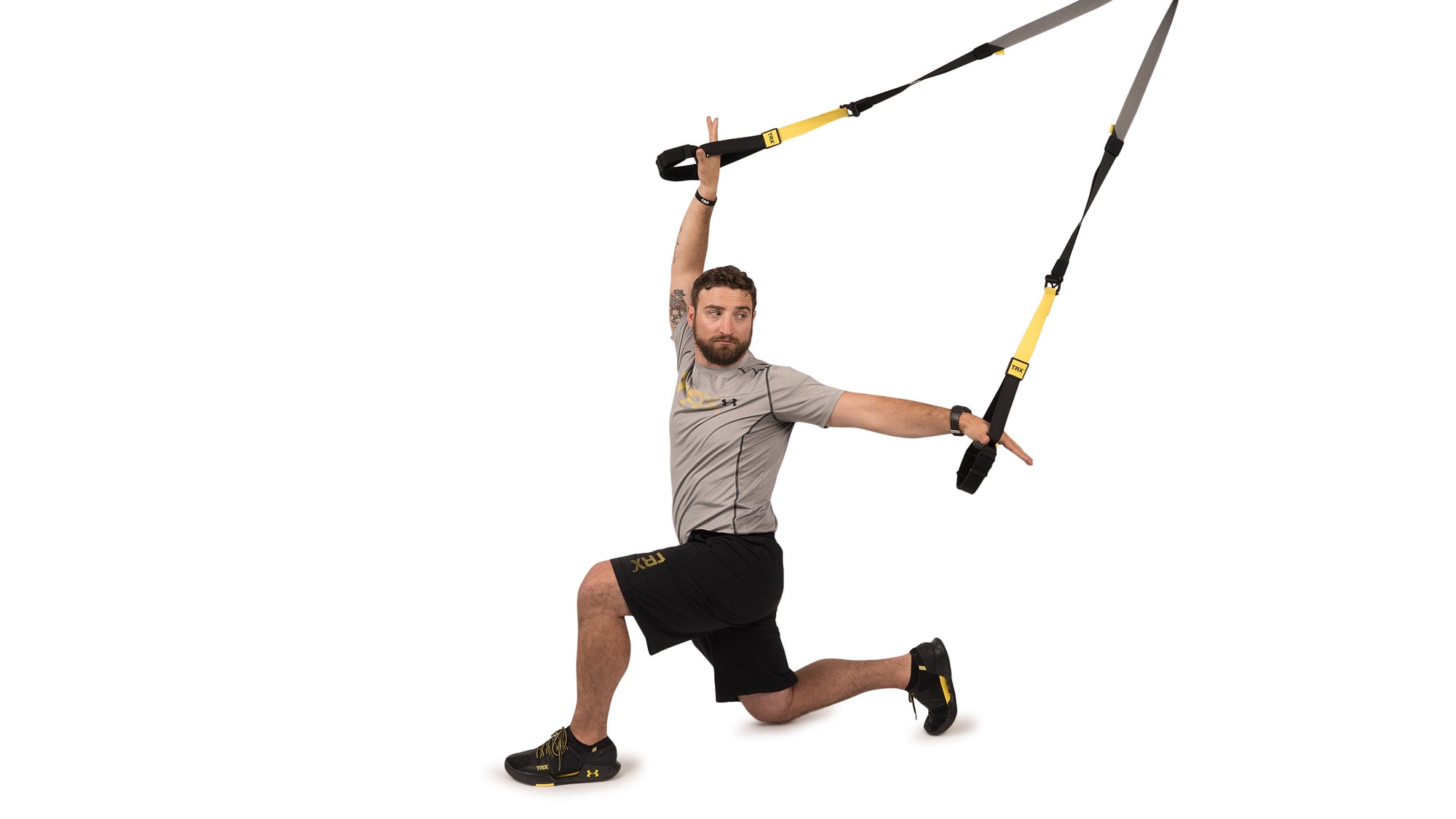
Crush This TRX Lower Body Workout in Under 20 Minutes
Tackle your New Year strength goals with some of our favorite TRX lower body strength exercises in the video below!
When creating a strength training routine, it’s easy to get distracted by the decorator muscles: biceps, triceps, traps, and abs. While it’s normal to have aesthetic goals,A comprehensive lower body workout should target both the anterior chain—hello, quads!— and posterior chain—we see you hamstrings and glutes. TRX and leg day are a natural pair because almost every exercise on the TRX Suspension Trainer requires standing or planking. Need more dynamism in your lower body routine? This workout uses the Suspension Trainer, Power Bag, and Exercise Bands to keep things interesting. Ready or not, those stems are going to get some attention.
We’re kicking off this party with the TRX Lunge, which tests your balance and strength while working the foot/ankle, knee and hip joints plus associated muscles, ligaments and tendons.
Adjust your Suspension Trainer to the mid-calf length, and stand facing away from the anchor point. Choose which foot you want to suspend, and thread that foot through both foot cradles. From your standing position, you’ll lower down on the planted, front leg to an almost-seated position, extended your suspended leg behind you. Then, pressing your front heel into the ground, drive back up to straighten your front leg and return to your standing position.
Challengers: you can increase the difficulty level of this move by either adding a single-leg hop or burpee at the top of the range of motion, wearing a weighted vest to complete this exercise, or adding a ball slam to each rep.
Next, grab your TRX Power Bag for a series of front squats and deadlifts. For the front squat, stand with your feet at hip distances, holding the Power Bag by your chest, then squat and drive back up to standing. For the deadlifts, start standing and maintain your foot position, but straighten your arms to extend the bag down. From here, you’ll hinge and push your hips back, letting the bag trace the front of your leg.
Finally, grab your Exercise Band, and slip it over your ankles for a squat side kick. Start with your feet hip-width apart. Take a deep squat, and as you drive back up to standing, extend your right leg straight out and to the right side. Repeat this move on the left side, and alternate between the two legs for the duration of the interval.
We’re going to mix all three moves together in an as-many-reps-as-possible (AMRAP) workout.
Starting with the TRX Lunge, your goal is to complete as many reps as possible in one minute on just one leg. Next, you’ll move to alternating Power Bag front squats and deadlifts for one minute, before finishing out with the alternating squat side kick AMRAP. You’ll get 30 seconds off to recover and prepare for the next round after each minute of work.
Complete the circuit four times so you have two TRX Lunge rounds on each leg.
Want to measure your improvement? Challenge yourself to complete this routine once a week for a month to see if your rep count during the AMRAP increases. (You’re aiming to improve each week.) When the month is up, create a new routine with three new exercises. With hundreds of variations on classic Suspension Trainer leg exercises, you can use the same tools to program fresh lower body workouts every month.

Cosgrove TRX Body Transformation Plan
No more excuses. If you or your clients have been talking about taking it up a notch with your workout routine, we've got just the thing for you: a results-oriented fitness program created just for us by fitness experts and owners of Results Fitness—Alwyn and Rachel Cosgrove. It's guaranteed to transform your body in three short weeks, just in time for summer!
The goal of this plan is to lose body fat, not weight. To start, take three "before" pictures (front, back and side) of each client. Men should wear shorts without a shirt, and women should wear shorts and a sports bra. Also, take a baseline body fat measurement for all participants, and ask them each to find a pair of jeans they can almost button. These measurements should be used as indicators of progress INSTEAD of a scale.
The two gender-specific workouts Alwyn and Rachel have created below are designed to take clients out of their comfort zones. The only way to change the body is to challenge it in new ways.
In addition to these workouts, all participants should clean up their diet for the next three weeks, eating lean protein and veggies every three to four hours and drinking half your bodyweight in water. Make a commitment not to splurge for the three week period. Checkout our blogs on nutrition for more information on healthy eating.
All of the following exercises should be performed at a moderate tempo. The exercises with the same number should be performed as a circuit (performing 1A, then 1B, etc.) until you finish all of the exercises with a 1, then repeat that circuit again before moving onto the next circuit.
THE MALE PLAN
The focus of this plan is high reps for more metabolic work, because most men never go above eight to 10 reps when it comes to their usual workouts. Performing 16 reps will be very challenging for most of your male clients. This plan finishes with an upper body circuit performed for eight reps to provide some extra hypertrophy for the arms and core.
#
Exercise
Reps
Rest
Sets
1A
TRX Lunge (w/ Touch and Hop)
16
30 secs
3
1B
TRX Inverted Row
16
30 secs
3
2A
TRX Balance Lunge to TRX Single Leg Squat
16
30 secs
3
2B
TRX Atomic Push-up
16
30 secs
3
3A
TRX Y Deltoid Fly
8
30 secs
2
3B
TRX Biceps Curl
8
30 secs
2
3C
TRX Triceps Extension
8
30 secs
2
3D
TRX Body Saw
8
30 secs
2
THE FEMALE PLAN
The focus of this plan is building strength, because most women usually do more aerobic type workouts and higher reps. NOTE: Each exercise should be performed at a level that is challenging for the eight reps. The last rep should feel like the individual has to "dig deep" to perform it. If any of the exercises seem too easy, help clients increase the intensity using the Principles of Progression. This plan will finish with a circuit of two exercises performed for as many reps as possible in 30 seconds to boost metabolism and burn fat.
#
Exercise
Reps
Rest
Sets
1A
TRX Hip Extension
8
30 secs
3
1B
TRX Single Arm Row
8
30 secs
3
2A
TRX Single Leg Squat
8
30 secs
3
2B
TRX Push-up
8
30 secs
3
3A
TRX Lunge
8
30 secs
2
3B
TRX Roll Out
8
30 secs
2
4A
TRX Jump Squat
30 secs
30 secs
2
4B
TRX Mountain Climber
30 secs
30 secs
2
At the end of the three weeks, take "after" photos from the same angles as before. Better yet, grab those too-tight jeans and try 'em on. Chances are, they'll now fit like a glove. Good luck to everyone who participates in this Body Transformation Plan, and be sure to encourage your clients to share their results below!
A sought after expert for several of the country’s leading publications including a regular contributor to Men’s Health magazine, Alwyn Cosgrove has co-authored three books and currently spends his time consulting on fitness training, training clients, speaking on the fitness lecture circuit and coaching fitness trainers worldwide. Rachel Cosgrove is an author and a fitness professional who specializes in getting women of all ages into the best shape of their lives. She has her own column in Women’s Health Magazine and has also been featured in numerous health and fitness publications and also had TV appearances on Fox, ABC and WGN. For the past decade, Alwyn and Rachel have run Results Fitness in Santa Clarita, California, ranked one of the top 10 best gyms in America by Men's Health.
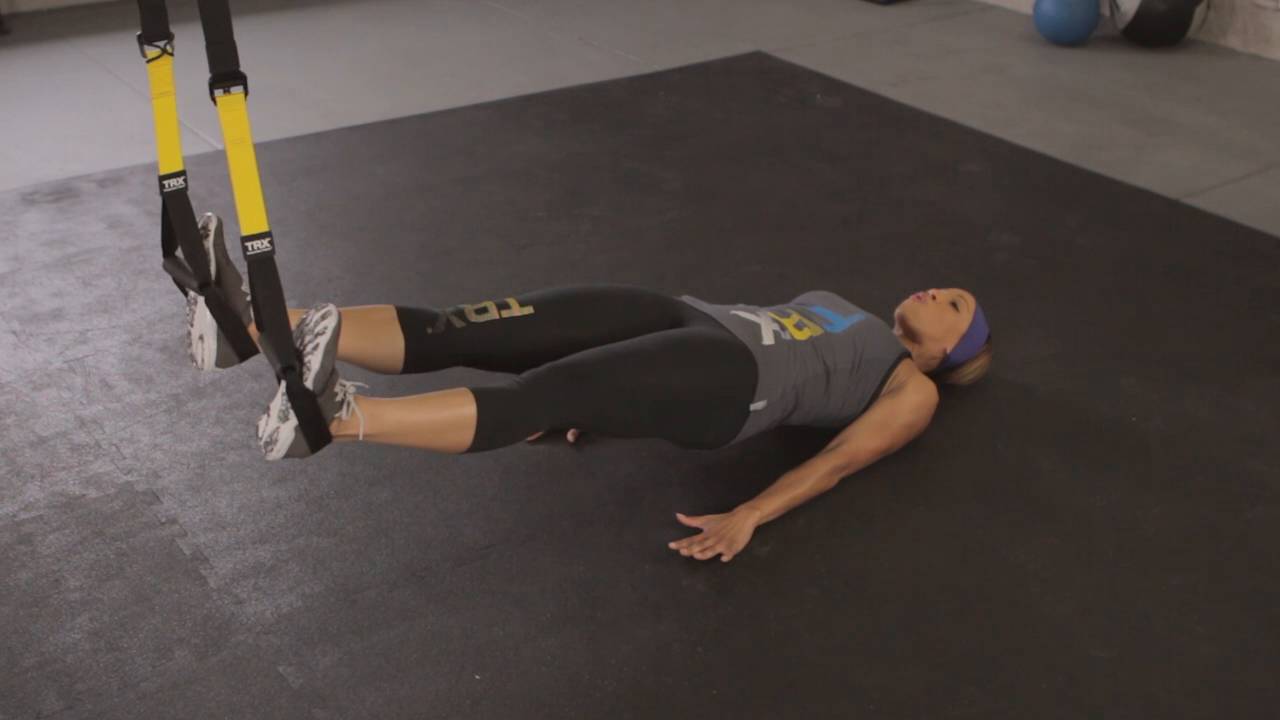
Core Workouts: 15-Minute Fitness with Basheerah Ahmad and TRX
If you want to trim, tone and strengthen your core and midsection, this 15-minute workout from celebrity trainer Basheerah Ahmad packs delivers all the moves you’ll need. Perfect for anyone who wants to see awesome results on a tight schedule, this workout delivers incredible core strength, fast. Each exercise can be modified and progressed to accommodate any fitness level, so there is no need to be intimidated - jump right in!
Perform each exercise for 60 seconds with 30 seconds rest in between each exercise. When you are finished with all five exercises, repeat the entire sequence, for a perfect 15-minute workout. Take our quick fitness quiz to get customized exercise modifications based on your current level.
TAKE OUR TRAINING QUIZ
TRX Planks (10 second holds/5 seconds rest) Get in a pushup position with your hands directly under your shoulders, and your feet in the foot cradles of the TRX Suspension Trainer. Brace your core and focus on keeping your shoulders, hips, knees and ankles all in line. Hold for ten seconds then drop your knees to the ground to rest for five seconds and repeat for one minute.
TRX Body SawsStart on the ground on your hands and knees with your feet in the foot cradles and your hands placed under shoulders. Get into a plank position with your forearms on the ground. Brace your core and make sure your ears, shoulders, hips, knees and ankles are all in line. Slowly rock forward and back just a few inches. Stop before you feel any strain on your lower back. Lower your knees to the ground to return to the start position.
TRX Hip AbductionStart on your back with your heels in the foot cradles of the TRX Suspension Trainer, and your hands palm-down pressing into the floor. Drive your heels into the foot cradles to lift your hips up into a plank position. Slowly separate your legs and until they make about a 45 degree angle. Pause for a moment, and then bring your feet back together.
TRX PikesGet in a pushup position with your feet in the foot cradles of the Suspension Trainer, directly under the anchor point. Brace your core and pike your hips up while letting your head drop between your arms, and moving your feet toward your upper body. Drop your hips back down under control, and return to a plank position.
TRX HingeStand facing the anchor point with the your arms extended in front of you pressing down on the TRX handles and your feet wider than shoulder width apart. Bend forward from the hips with a straight back, pushing your hips back and extending your arms forward. Drive your hips forward to return to the start position.
If you want more fat-burning, muscle-toning workouts from Basheerah and TRX be sure to watch the rest of the 15-Minute Fitness Workout series, here.
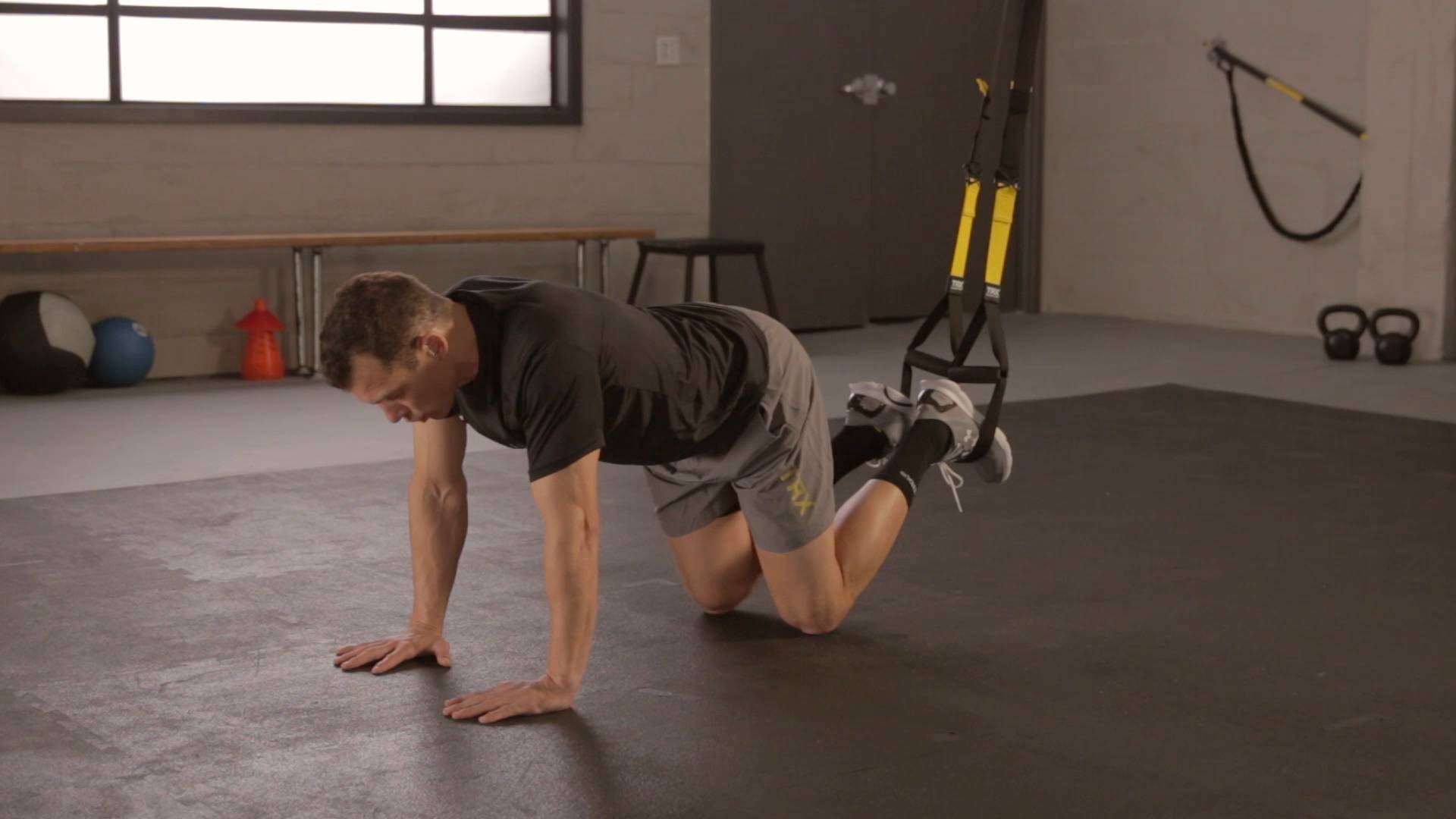
Core Workout: 15-Minute Fitness with Jay Cardiello
Get strong, lean, firm abs with this super simple, 15-minute core workout from celebrity fitness expert Jay Cardiello and TRX. Want to find the perfect core exercises for your fitness level? Take our quick assessment quiz to get a personalized ab-sculpting plan. Designed to for all fitness levels, these exercises provide the perfect punch of strength training for the midsection of your dreams. Performing any exercise on the TRX Suspension Trainer fires up your core in a way that no other equipment can, and this workout combines all the best TRX has to offer.
TAKE OUR TRAINING QUIZ
Perform each exercise for 60 seconds, resting for 30 seconds while you transition to the next movement. When you finish all five exercises start run through the sequence one more time for a 15-minute workout. For the first round perform the planks on your right side, then switch to the left for the second.
TRX Side PlanksLie on your side with your feet in the foot cradles and the heel of your top foot touching the toe of your bottom foot. Squeeze your core and glutes to lift your hips up, keeping your shoulders over your hand. Lower your hips to the ground to return.
TRX Body SawStart on the ground on your hands and knees with your feet in the foot cradles and your hands placed under shoulders. Plank up into a pushup position keeping your hands directly under your shoulders. Brace your core and make sure your ears, shoulders, hips, knees and ankles are all in line. Slowly rock forward and back just a few inches. Stop before you feel any strain on your lower back. Lower your knees to the ground.
TRX PikesGet in a pushup position with your feet in the foot cradles of the Suspension Trainer, directly under the anchor point. Brace your core and pike your hips up while letting your head drop between your arms, and moving your feet toward your upper body. Drop your hips back down under control, and return to a plank position.
TRX Mountain ClimbersAdjust the Suspension Trainer to mid calf and start on the ground with your toes in the foot cradles in a plank position. Draw one knee in towards you chest while raising your hips and keeping your other leg straight. Lower your hips down and straighten out your leg to return to the start position. Repeat with the other leg.
TRX Hip AbductionStart on your back with your heels in the foot cradles of the TRX Suspension Trainer, and your hands palm-down pressing into the floor. Drive your heels into the foot cradles to lift your hips up into a plank position. Slowly separate your legs and until they make about a 45 degree angle. Pause for a moment, and then bring your feet back together.
For more workouts from Jay Cardiello and TRX, check the rest of our 15-Minute Fitness Series.
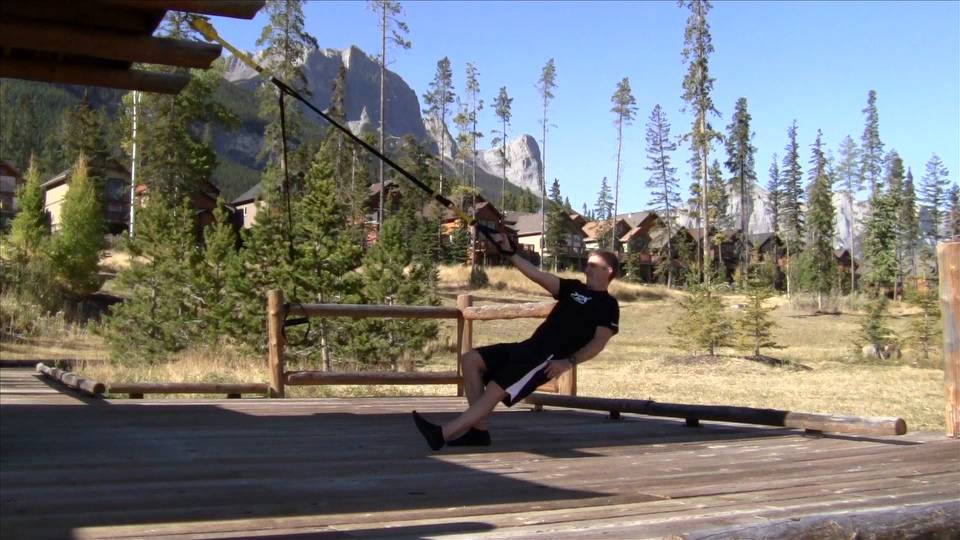
Cool Combo: TRX Unilateral Exercise Sequence
Watch as TRX Head of Training and Development Fraser Quelch shows us an awesome unilateral exercise sequence on the TRX Suspension Trainer. Take our quick form assessment quiz for personalized tips on mastering these moves. He moves from a TRX Single Arm Raise to a TRX Biceps Curl to a TRX Triceps Extension to a TRX High Row, all performed on just one arm. This is guaranteed to light up the arm, chest and shoulder of the working side but the core as well.
TAKE OUR TRAINING QUIZ
Why is unilateral training important? Each of us has a dominant body side. We throw better from one side, we kick better from one side, and, likewise, we're stronger on one side. Ever tried tossing a football with your non-throwing arm? If so, you've probably found it a very humbling experience. When we lift weights bilaterally (i.e., move the weight with both arms at once), our dominant side takes over during the exercise, causing a disproportion, however slight, in workout balance. So even though you think you're working both sides of the body equally, in reality, the dominant side controls the exercise.
Fortunately, we can train the weak side with unilateral training exercises like those in the sequence above. It targets our weak areas and activates nerves and fibers that force muscles to adapt and grow.
Give the above exercise sequence a shot and tell us what you think below!
Buy your TRX Suspension Trainer here.
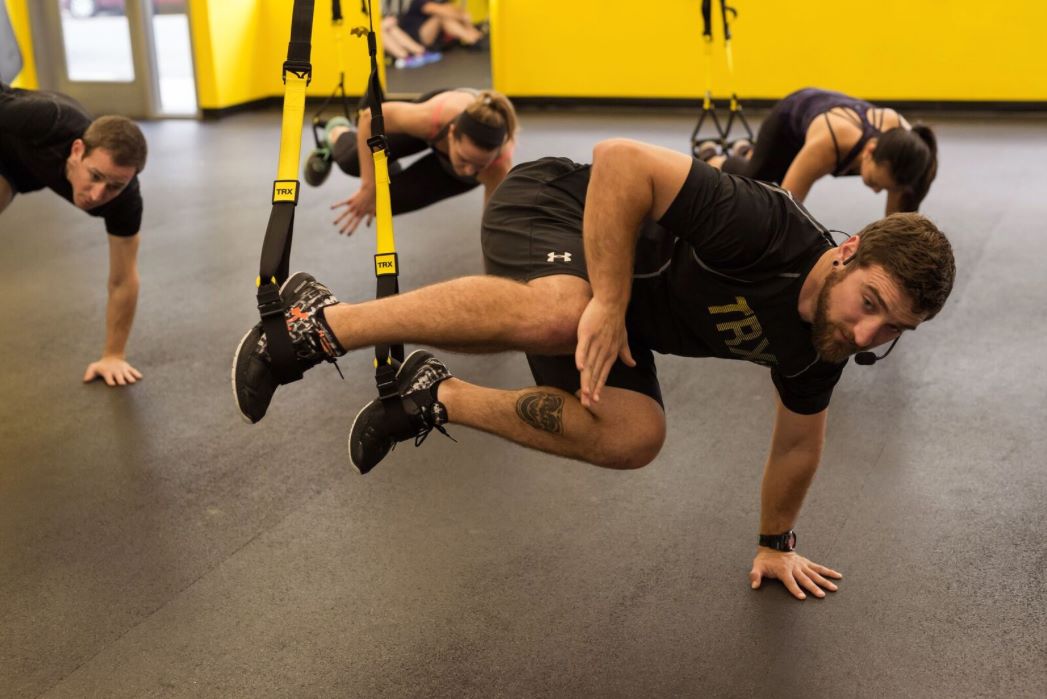
Meet Zack: The Nice Guy Serving Up Tough Workouts
To take Zack Van Wagoner’s TRX LIVE classes is to know—with near certainty—that your arms are going to fall off. But in a good way. ZVW is a nice guy, but he does not mess around.
Born and raised in California, Van Wagoner moved from his hometown of Ceres to San Francisco for college. As a kinesiology major focusing on Exercise Science, it’s no surprise that Van Wagoner liked spending time at the gym. So, as many college students do, he got a job at one.
Van Wagoner started working the front desk at Crunch Fitness and was hired as a trainer after getting certified through NASM. After taking the TRX Suspension Training Course, teaching TRX classes at Crunch, and working his way up the ladder to becoming manager, he was ready for a different kind of challenge—one that required wearing lots of black and yellow.
Van Wagoner began teaching at the TRX Training Center—the real-life studio and TRX headquarters where most of the TRX magic happens—in 2015 and joined the education team in 2016. Today, he splits his time between coaching workouts and developing professional education and content for the company.
Lest you think that Zack is only bringing the pain, rest assured that he can handle any workout he dishes out. For his own routine, he gravitates toward strength and conditioning weight work, coupled with TRX Suspension Trainer exercises. His personal workouts often see a second life as his TRX class workouts. “Now that all the shelter in place stuff is happening, I’m back into my TRX-kettlebell-band work. I'm trying to use bands a lot more now.”
When he’s not working or exercising, Van Wagoner enjoys exploring the Bay Area with his girlfriend. “I've lived here for 11 years, and I still haven't seen everything.” Whether it’s checking out the restaurants and mural-covered alleys of San Francisco’s Mission District or crossing the Golden Gate Bridge to hike in neighboring Marin County, he’s always on the lookout for the hidden—and not-so-hidden—treasures of Northern California.
Like many of us during stay-at-home directives, Van Wagoner jokes that his hobbies are non-essential services and standing close to people, but he maintains a positive outlook. He’s still coaching. He can still go hiking. And he can still get his favorite burrito. (That would be at San Francisco’s La Taqueria, and Zack insists that you try it grilled, a.k.a. “dorado-style.”) Yes, Van Wagoner is a nice guy. Just try to remember that the next time you can’t lift your arms after one of his TRX LIVE workouts.
